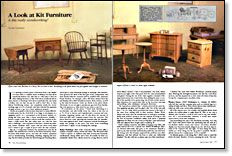
Synopsis: Kits can satisfy the woodworking urge for a lot of people, and they have whetted the appetites of many novices to go on to more ambitious projects. Jim Cummins evaluated a range of projects and manufacturers and focuses here on pieces he found to be most interesting to a woodworker. He discusses each manufacturer’s concerns and compromises regarding quality and talks about the amount of work and skill each expects from the customer. Side information details knockdown furniture options and a profile of Cohasset, a kit manufacturer from the 1940s.
Is it cheating to build a piece of furniture from a kit? Maybe it is if you have a complete home workshop, but how about somebody without one, who has no other way to find out what making furniture is like? How about somebody whose main interest is finishing? How about somebody who just wants a hobby, and one that can pay for itself at that? Kits, in their almost bewildering variety, can completely satisfy the woodworking urge for a lot of people, and have whetted the appetites of many novices to go on to more ambitious projects.
Clocks are popular as kits because they have so many difficult to-make parts, but the clock field is too large to encompass in a magazine article. So I concentrated on kit furniture instead, ordering kits from more than a dozen manufacturers. Frankly, I found a couple of the projects tedious work that resulted in furniture I didn’t much like. But others were not only fun, they were a challenge. I was surprised to find that I needed my tablesaw, jointer, bandsaw, lathe, router, and just about every hand tool I owned to get a couple of pieces done the way I wanted.
Kits are a compromise between the manufacturer and the kit builder. The manufacturer invests in the heavy machinery, benefits from bulk lumber prices, and does the trickier operations such as steambending, dovetailing, doweling, shaping and turning. The kit builder provides the hand-fitting and finishing labor, and hopes to reap substantial savings in exchange. The manufacturer governs the level of the first part of the compromise, and must decide what the customer will be satisfied with. American Forest Products, for example, sells a $60 three drawer-chest kit, and Bartley sells a $990 blockfront bureau. Both of these, as well as the other kit furniture I built, are shown in the photo above. Obviously, it’s not enough to say that you get more from Bartley. The real question is, what level do you want to aim for?
I’ll concentrate on the pieces I found most interesting to a woodworker, and talk briefly about the others in the box on p. 79. I’ll try to discern each manufacturer’s concerns and compromises regarding quality, and I’ll talk about the amount of work and skill each company expects from the customer. The prices listed are retail, ignoring any seasonal sales the manufacturer may regularly have. Some companies include finishing materials and postage in the price, and some don’t—something you’ll have to figure out by studying the catalogs.
For the full article, download the PDF below:
From Fine Woodworking #51
Fine Woodworking Recommended Products

Compass

Drafting Tools

Dividers






















Log in or create an account to post a comment.
Sign up Log in